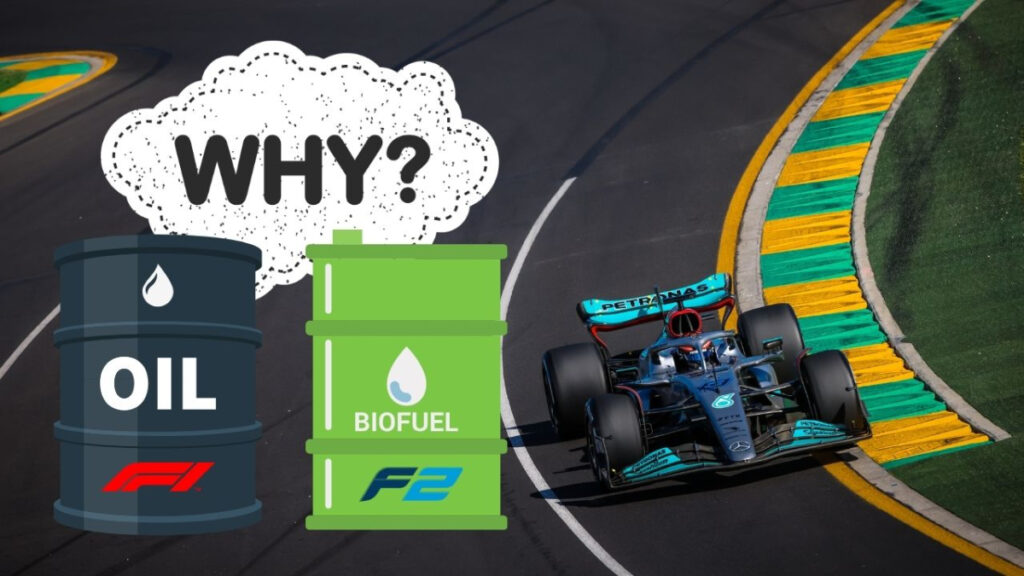The second week of the season is here, and it’s home Grand Prix of Aramco – Formula 1 global partner, as well as fuel supplier to F2. Interestingly, depending on the championship, on-track battles on the Jeddah Street Circuit are set to leave a drastically different environmental footprint. And this time faster won’t mean better, as Formula 2 is using more sustainable fuel than its older brother. Here is why.
Formula 2 is using more sustainable fuel made by Aramco
To understand the primary reasons behind the counterintuitive environmental performance of fuel in each series, we must answer a simple question – what’s the difference?
Fuel used in Formula 1 can be referred to as E10, which only in 10% relies on bioethanol. Although, according to F1’s Chief Technical Officer Pat Symonds, ethanol is fully sustainable, the E10 fuel belongs in the same category with other carbon-intensive fossil fuels.
Formula 2 cars, on a contrary, are powered by 55% Advanced Sustainable Fuel made by Aramco. It means 45% fossil fuel refined petrol is mixed with 55% lower-carbon bio components.
55% beats 10% fair and square. Subsequently, Formula 2 is using more sustainable fuel than Formula 1.
Short on time? Dive into this reel to take in valuable knowledge on sustainable fuel
Formula 2 – guinea pig in the F1 paddock
Advanced Sustainable Fuel by Aramco was introduced to F2 back in 2023, so 3 years before F1 goes all in on sustainably powered cars. It may be surprising at first, however it is a part of a bigger picture. Let’s look at it.
We need to remember that Formula 1 and Formula 2 rather than minding their own business are often partners in crime. Introducing sustainable fuel to the feeder series first is no different.
Click here to find out what are the sustainable fuels trends to look out for in 2024
By being supplied with sustainable fuel, Formula 2 has become Formula 1’s test-bed. F2 using these fuels now gives F1 access to an up-to date data, putting the pinnacle of motorsport in a perfect position to be ready to embrace sustainable fuels in 2026.
Ultimately, possessing a deep understanding of high-level expertise stands as the foremost safeguard against potential failures.
„Symbol for sustainability” – story behind F2 next gen car
Why then, if there is an urgent need for extending the knowledge and understanding, F1 is not going to accommodate this technology itself? It seems like a perfect opportunity to leverage close partnership with Aramco – the very same Aramco delivering 55% ASF to F2 & F3.
Well, speaking from my experience, I would dare to argue that Formula 1 simply fears failure. If F1 took a risk of racing on sustainable fuel already now and ended up being exposed by relatively low reliability and general worse performance, that would lead to adverse publicity for both the series and new-coming technology.
Formula 2, on the other hand, won’t find itself under this type of scrutiny even if cars racing on sustainable fuels would turn out to be a disaster. It’s not only a matter of popularity, but also F2 being a spec series.
The latter means there is only one car supplier for the entire grid in Formula 2. It takes away a dimension of rivalry present in F1, which may have steered some people away from sharing the knowledge. It also guarantees less work, as the same thing is done once for the all entrants.
A brand-new car introduced to F2 in 2024 is a testimony of this approach. In the context of sustainable fuels, it will continue the guinea pig journey, trying to extract the best out of them. Its adaptability aims to allow introduction of first synthetic components i.e. CO2 captured directly from the atmosphere in 2025 and 2026.
Taking all that into consideration, it should come as no surprise that F1 CEO – Stefano Domenicali – is happy with Formula 2 using more sustainable fuels than Formula 1 in 2024.
The new F2 car is also an important symbol for our sustainability journey as the series continues to pioneer advanced sustainable fuel which will become a part of F1 from 2026. I want to pay tribute to Bruno Michel and his team as well as the FIA for our continued strong collaboration in this category
Stefano Domenicali
